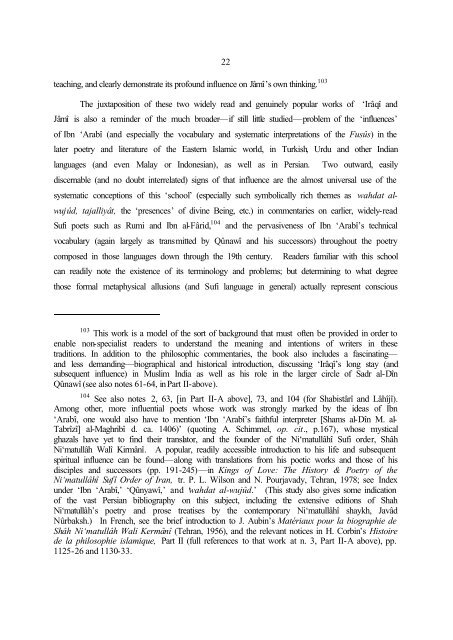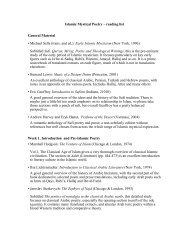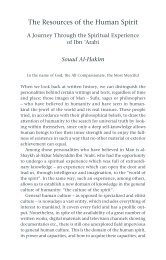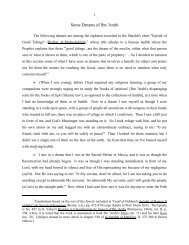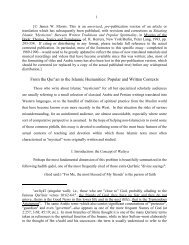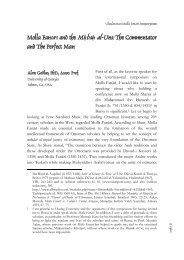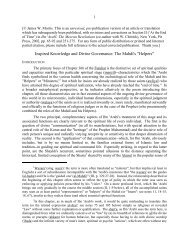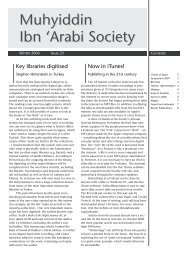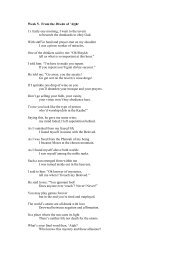Part III (pdf) - Muhyiddin Ibn Arabi Society
Part III (pdf) - Muhyiddin Ibn Arabi Society
Part III (pdf) - Muhyiddin Ibn Arabi Society
Create successful ePaper yourself
Turn your PDF publications into a flip-book with our unique Google optimized e-Paper software.
22teaching, and clearly demonstrate its profound influence on Jâmî’s own thinking. 103The juxtaposition of these two widely read and genuinely popular works of ‘Irâqî andJâmî is also a reminder of the much broader—if still little studied—problem of the ‘influences’of <strong>Ibn</strong> ‘Arabî (and especially the vocabulary and systematic interpretations of the Fusûs) in thelater poetry and literature of the Eastern Islamic world, in Turkish, Urdu and other Indianlanguages (and even Malay or Indonesian), as well as in Persian. Two outward, easilydiscernable (and no doubt interrelated) signs of that influence are the almost universal use of thesystematic conceptions of this ‘school’ (especially such symbolically rich themes as wahdat alwujûd,tajalliyât, the ‘presences’ of divine Being, etc.) in commentaries on earlier, widely-readSufi poets such as Rumi and <strong>Ibn</strong> al-Fârid, 104 and the pervasiveness of <strong>Ibn</strong> ‘Arabî’s technicalvocabulary (again largely as transmitted by Qûnawî and his successors) throughout the poetrycomposed in those languages down through the 19th century. Readers familiar with this schoolcan readily note the existence of its terminology and problems; but determining to what degreethose formal metaphysical allusions (and Sufi language in general) actually represent conscious103 This work is a model of the sort of background that must often be provided in order toenable non-specialist readers to understand the meaning and intentions of writers in thesetraditions. In addition to the philosophic commentaries, the book also includes a fascinating—and less demanding—biographical and historical introduction, discussing ‘Irâqî’s long stay (andsubsequent influence) in Muslim India as well as his role in the larger circle of Sadr al-DînQûnawî (see also notes 61-64, in <strong>Part</strong> II-above).104 See also notes 2, 63, [in <strong>Part</strong> II-A above], 73, and 104 (for Shabistârî and Lâhîjî).Among other, more influential poets whose work was strongly marked by the ideas of <strong>Ibn</strong>‘Arabî, one would also have to mention ‘<strong>Ibn</strong> ‘Arabî’s faithful interpreter [Shams al-Dîn M. al-Tabrîzî] al-Maghribî d. ca. 1406)’ (quoting A. Schimmel, op. cit., p.167), whose mysticalghazals have yet to find their translator, and the founder of the Ni‘matullâhî Sufi order, ShâhNi‘matullâh Walî Kirmânî. A popular, readily accessible introduction to his life and subsequentspiritual influence can be found—along with translations from his poetic works and those of hisdisciples and successors (pp. 191-245)—in Kings of Love: The History & Poetry of theNi‘matullâhî Sufî Order of Iran, tr. P. L. Wilson and N. Pourjavady, Tehran, 1978; see Indexunder ‘<strong>Ibn</strong> ‘Arabî,’ ‘Qûnyawî,’ and ‘wahdat al-wujûd.’ (This study also gives some indicationof the vast Persian bibliography on this subject, including the extensive editions of ShahNi‘matullâh’s poetry and prose treatises by the contemporary Ni‘matullâhî shaykh, JavâdNûrbaksh.) In French, see the brief introduction to J. Aubin’s Matériaux pour la biographie deShâh Ni‘matullâh Wali Kermânî (Tehran, 1956), and the relevant notices in H. Corbin’s Histoirede la philosophie islamique, <strong>Part</strong> II (full references to that work at n. 3, <strong>Part</strong> II-A above), pp.1125-26 and 1130-33.


